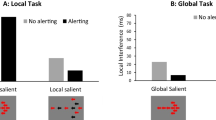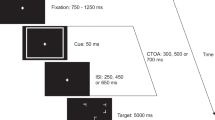Abstract
Alertness has been construed as one of three fundamental components of attention. When generated by a warning signal, phasic changes in alertness ubiquitously decrease reaction time. But how does it do so? Based on earlier findings, in 1975, Posner proposed a theory of phasic alertness with two postulates: (i) phasic alertness does not affect the accumulation of information; (ii) phasic alertness accelerates when a response based on the accumulating information will be generated. When targets are continuously presented, this theory predicts that alertness will reduce reaction at the expense of an increase in errors—that is, generate a speed–accuracy trade-off. Los and Schut, Cognitive Psychology, 57, 20–55, (2008), while endorsing Posner’s theory, claimed to have failed to replicated the tell-tale trade-off reported by Posner et al. Memory and Cognition, 1, 2-12, (1973, Experiment 1). The primary goal of this commentary was to use all the data from Los and Schut to see if the predicted speed-accuracy trade-off would be verified or not. With the increased power, it was confirmed that the conditions that benefited the most in reaction time from alertness also had higher error rates. It is noteworthy that recent studies have generated replications and extensions of the methods and findings of Posner et al; thus, it appears that the empirical pattern predicted by Posner’s theory of phasic alertness is relatively robust.




Similar content being viewed by others
Notes
My emphasis on “faster versus slower” rather than specific SOAs was motivated by my understanding of Posner’s theory and how the SAT was described in Posner et al. (1973): “Errors tend to be highest where reaction time is fastest (e.g. foreperiods of 50–200 msec) and lowest where reaction time is slowest (e.g., 0 and 800 msec)” (p.3).
To preserve the shape of the functions of performance (RT and errors) as a function of SOA, the average performance measures (M) for each experiment were computed for the SOAs that the three experiments had in common (SOAs: from 50–300 ms). The difference between E1 and the other two experiments was computed. Then these differences (D) were subtracted from the RTs and error rates (X) for each SOA of each of Experiments 3 and 4 before the adjusted scores (A) from the two experiments with slower RTs (E3,4) were combined (simple average weighted by number of participants in each experiment) with those of E1 and plotted in Fig. 4. The math used (for RT) is illustrated below:
Xtij = reaction time (t) for each experiment (i=1,3,4) and each of the common SOAs (j)
Mti, where t=RT, and i=experiment (1,3,4),
is the mean RT across SOAs from 50-300 for each experiment (i)
Dti = Mti - Mt1, for i=3,4
essentially this represents how much slower RTs were in E3 and E4 than in E1
Atij = Xtij - Dti, for i=3,4, j=SOA from 50-300
adjusted scores (A)
Connectionist and diffusion modeling (both of which are described in the general discussion of Schneider’s (2018) exploration of the interaction between alertness and cognitive control) are two such methods. I have one recommendation for future scholars interested in using diffusion modelling as a framework for understanding Posner’s theory, generating predictions from it and testing it against alternative theories. It is natural in such models to imagine increasing errors while decreasing RT by decreasing the threshold amount of evidence required to select a response. This is often referred to a shifting to a more liberal response criterion (e.g., see Han & Proctor, 2022, 2023). Posner’s theory, however, as described in the introduction, would be more appropriately modelled by assuming that there is a noisy deadline for making a response based on the information that had accumulated by the deadline, and that this deadline is accelerated by phasic alertness. Decreases in these two parameters (threshold and deadline) can both generate SATs, but they might differ in subtle ways when the full pattern of results is considered.
References
Aston-Jones, G., Chen, S., Zhu, Y., & Oshinsky, M. L. (2001). A neural circuit for circadian regulation of arousal. Nature Neuroscience, 4(7), 732–738.
Han, T., & Proctor, R. W. (2023). Effects of a neutral warning signal under increased temporal uncertainty. Memory & Cognition, 1–12. Advance online publication. https://doi.org/10.3758/s13421-023-01404-8
Han, T., & Proctor, R. W. (2022). Effects of a neutral warning signal on spatial two-choice reactions. Quarterly Journal of Experimental Psychology, 75(4), 754–764.
Klein, R., & Kerr, B. (1974). Visual signal detection and the locus of foreperiod effects. Memory & Cognition, 2, 431–435.
Klein, R. M., & Lawrence, M. A. (2011). The modes and domains of attention. In M. I. Posner (Ed.), Cognitive neuroscience of attention (2nd ed., pp. 11–28). Guilford Press.
Lawrence, M. A., & Klein, R. M. (2013). Isolating exogenous and endogenous mechanisms of temporal attention. Journal of Experimental Psychology: General, 142(2), 560–572. https://doi.org/10.1037/a0029023
Los, S. A., & Schut, M. L. (2008). The effective time course of preparation. Cognitive Psychology, 57(1), 20–55.
Mackworth, N. H. (1948). The breakdown of vigilance during prolonged visual search. Quarterly Journal of Experimental Psychology, 1, 6–21.
McCormick, C. R., Redden, R. S., Hurst, A. J., & Klein, R. M. (2019). On the selection of endogenous and exogenous signals. Royal Society Open Science, 6(11), 190134.
Miniussi, C., Wilding, E. L., Coull, J. T., & Nobre, A. C. (1999). Orienting attention in time: Modulation of brain potentials. Brain, 122(8), 1507–1518.
Nobre, A. C. (2001). Orienting attention to instants in time. Neuropsychologia, 39(12), 1317–1328.
Nobre, A. C., & Van Ede, F. (2018). Anticipated moments: temporal structure in attention. Nature Reviews Neuroscience, 19(1), 34–48.
Pachella, R. G. (1974). The interpretation of reaction time in information-processing research. In B. Kantowitz (Ed.), Human information processing: Tutorials in performance and cognition (pp. 41–82). Erlbaum.
Petersen, S. E., & Posner, M. I. (2012). The attention system of the human brain: 20 years after. Annual Review of Neuroscience, 35, 73–89.
Posner, M. I. (1975). The psychobiology of attention. In C. Blakemore & M. Gazzaniga (Eds.), Handbook of psychobiology. Academic Press.
Posner, M. I. (1978). Chronometric explorations of mind. Lawrence Erlbaum.
Posner, M. I., & Boies, S. J. (1971). Components of attention. Psychological Review, 78, 391–408.
Posner, M. I., & Petersen, S. E. (1990). The attention system of the human brain. Annual Review of Neuroscience, 13(1), 25–42.
Posner, M. I., Klein, R. M., Summers, J., & Buggie, S. (1973). On the selection of signals. Memory & Cognition, 1, 2–12.
Rusak, B., & Zucker, I. (1979). Neural regulation of circadian rhythms. Physiological Reviews, 59(3), 449–526.
Schneider, D. W. (2018). Alertness and cognitive control: Testing the early onset hypothesis. Journal of Experimental Psychology: Human Perception and Performance, 44(5), 756–766.
Weinbach, N., & Henik, A. (2012). Temporal orienting and alerting—The same or different? Frontiers in Psychology, 3, 236.
Wickelgren, W. (1977). Speed–accuracy trade-off and information processing dynamics. Acta Psychologica, 41, 67–85.
Wundt, W. M. (1904). Principles of physiological psychology (E. Bradford Titchener, Trans.). London: Swan Sonnenschein. (Original work published 1902)
Author note
It was in 2020 that I became interested in exploring the data from Los and Schut (2008). When I requested the data from Sander Los it was quickly and graciously provided. Because the publication was from 12 years earlier, I was pleasantly surprised that it could be found and found so quickly. This interest, buried then by other tasks, was revived when I was recently asked to provide a review of the Han and Proctor paper that would eventually be accepted for publication in the 50th anniversary issue of Memory & Cognition. The 1973 issue has a special meaning for me because my first journal article (Posner et al., 1973) was published in, and as, the inaugural issue’s first article. I am grateful to Sander Los for making this commentary possible and for the financial support I have received from the Natural Sciences and Engineering Research Council of Canada since 1975.
Author information
Authors and Affiliations
Corresponding author
Additional information
Publisher's note
Springer Nature remains neutral with regard to jurisdictional claims in published maps and institutional affiliations.
Rights and permissions
Springer Nature or its licensor (e.g. a society or other partner) holds exclusive rights to this article under a publishing agreement with the author(s) or other rightsholder(s); author self-archiving of the accepted manuscript version of this article is solely governed by the terms of such publishing agreement and applicable law.
About this article
Cite this article
Klein, R.M. Assessing the predictions from Posner’s theory of phasic alertness using data from Los and Schut (2008). Mem Cogn 52, 1–6 (2024). https://doi.org/10.3758/s13421-023-01438-y
Accepted:
Published:
Issue Date:
DOI: https://doi.org/10.3758/s13421-023-01438-y




